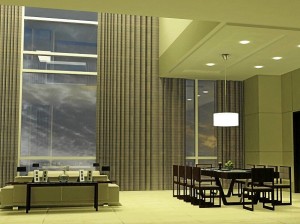Recognizing the various types of glazing

LOW-EMISSIVITY glass will work wonders for spaces that have large windows like these, deflecting radiant heat and maintaining the internal temperature of the rooms.
The world has become a complicated place, hasn’t it? We have so many options that it sometimes sets hurdles in the process of decision-making. But in the design field, the world of choices makes finding the right things to put together more fun. I was going through the glass samples in my library, and from what I managed to pick up, I can say that the industry has truly jetted forward, what with so many options developed with new technology. Glass has also gone beyond merely being a functional element: it has become one of the most exploited decorative materials today.
Clear glass, its most basic of form, has many variants. The most basic type of glass—float glass—was commonly used many years back but has since evolved into many other types. What looks like regular clear glass today would have already been treated to be either annealed, tempered or laminated—and this is just for starters—the latter two being the most popularly used.
Treated
Annealed glass undergoes a process of heating and slow cooling in order to strengthen the glass. Tempered (sometimes called “toughened”) glass, on the other hand, is heated to a very high temperature, strengthening the glass but making it quite brittle. Laminated glass is made from two thin sheets of glass and a thin film in between, holding the glass together even when it shatters.
Annealed breaks into large harmful shards and is hardly used, except when budgets don’t allow for safer glass options, and when it is used for small panels that are unlikely to break. Tempered is used for applications where glass risks falling on, and hurting, a person.
Frameless glass doors or very large window panels employ the use of tempered glass, because it breaks into kernel-sized fragments possibly still causing cuts but almost guaranteeing no major casualties, thanks to the sheer smallness of the broken pieces.
Now, if you don’t want those broken pieces to fall, then opt for a laminated tempered glass panel. This is my favored glass for “moving parts” like larger framed glass panels on doors and windows, or framed shower enclosures. Undoubtedly the safest. It’s the type of glass used for car windshields. For large frameless doors though, a thick (12-millimeter) tempered glass panel will usually work for a normal-sized panel.
Other types
There are other types of glass that are functional yet decorative, just like my favorite sandblasted glass. Its shortfall is that it captures fingerprints on its sandblasted side, which is why I’d rather—for a similar effect—just use clear glass, and apply a 3M film that simulates that “frosted” or sandblasted look. Though it will require a little more care in cleaning, the film makes the glass look less green and leaves no visually annoying smudges. What I like most about this particular glass treatment is that it diffuses light and creates as soft and ethereal atmosphere.
Then there’s another type of sandblasted glass called the “lamifrost” glass: two sandblasted panels laminated together with the sandblasted sides face to face and the glazed sides exposed. It results in a denser sandblasting where only shadows or silhouettes are visible through the glass. I like using this for shower enclosures and partitions where light needs to filter through but allows for more privacy. I’ve used these as free-standing partitions or as glass walls, too.
Sustainability and issues relating to heat control have brought about low-emissivity glass, or “Low-E” glass. This type of glass is coated with a material that reflects radiant heat while allowing light to come in. It is used for external architectural applications like doors, windows, large picture windows and curtain wall systems. In essence, it keeps the heat—or cold—out. And because of that, it helps maintain the internal temperature of a space.
Another modern glass is the self-cleaning glass, which is manufactured with a coat of titanium dioxide causing ultra-violet rays from the sun to break down organic material (like bird poo, yes) that attaches to its surface. It also causes water to coat the glass to wash away the broken down wastes. This type of glass will work best where the weather constantly alternates between sun and rain (that sounds like ours!). Whether it really works for practical application, we still don’t know for it is fairly new technology.
On the functional aspect, there are many other types of glass used for a specific performance required. The above are those you’ll likely stumble upon when designing or constructing your spaces. The others may be a little too technical—and not very useful—to discuss here. As for the more creative types of glass? We’ll get there next week!
Contact the author through designdimensions@abi.ph or through our Asuncion Berenguer Facebook account.
